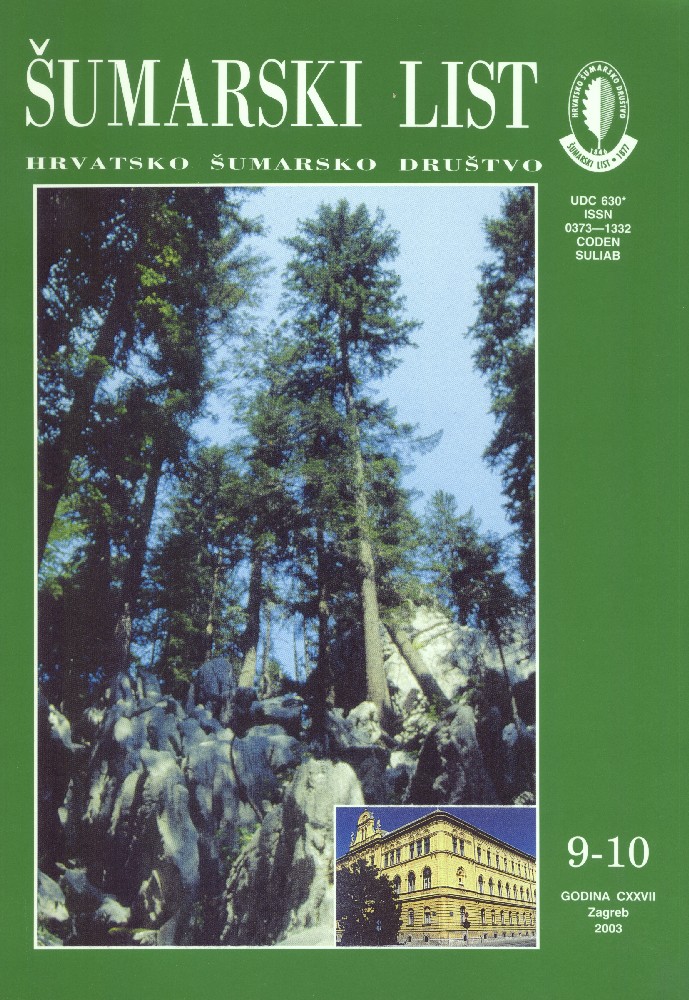
broj: 9-10/2003
pdf (21,7 MB) |
|
||||||||||||||
| IZVORNI ZNANSTVENI ČLANCI | ||
| Idžojtić, M. | UDK 630* 442 (001) | |
| Hosts and Distribution of the White-berried Mistletoe (Viscum album L. ssp. album) in Croatia pdf HR EN | 439 | |
| Krejči, V., Dubravac, T. | UDK 630* 231 + 226 (001) | |
| Possibility and Justification of the Shelterwood Cutting Method in the Beech Forests of Gorski Kotar, Lika and Hrvatsko Primorje pdf HR EN | 449 | |
| Klobučar, D. | UDK 630* 583 + 585 (001) | |
| Assessment of the Accuracy of Geocoding the Basic Map of Croatia and the Digital Orthophotography pdf HR EN | 457 | |
| PRETHODNO PRIOPĆENJE | ||
| Prka, M. | UDK 630* 443 + 323 + 325 | |
| Occurrence of False Heartwood in Beech Trees and Technical Beech Roundwood Coming from Thinning and Preparatory Fellings in the Area of Bjelovar Bilogora pdf HR EN | 467 | |
| STRUČNI ČLANCI | ||
| Margaletić, J., Margaletić, M. | UDK 630* 435 + 432 | |
| Fires in Forests and Forestlands as Habitat Degradation Factors pdf HR EN | 475 | |
| Sabadi, R. | UDK 630* 904 | |
| German Forestry in 2002/2003 pdf HR EN | 483 | |
| Summary: Forestry in Germany on 30 % of its total teritory fulfils important tasks of ensuring of natural conditions of life, subsitent production of timber raw material, and development of space´s scenery. The central aim of forest policy of the Federal State and Länder is to maintain and improve the ability of forests to fulfill subsistently in the best way the multitude of its functions. For this purpose, based on density of population and structure of the German forests, as a rule, the planed forestry is required. The most of forest areas fulfil more functions at the same time, maintaining multifunctionality, on same areas single functions having priority (e.g. nature protection, erosion and avalanche control, recreation etc.). The production of wood for energy in 2000 at the level of EU was 47.3 million TOE. Said production primarily was used for termic purpose (85 %), but also for the generation of electric power (29.6 Twh). Wood as energent has in the EU share of 6.3 % of the total production of primary energy, but covers only 2 % of energy consumption. Nevertheless, wood is the primary renewable energy source, sharing with 54 % in the total consumption of renewable energy sources . The greatest producer of energy obtained from wood in the EU is France, Sweden, Finland and Germany. These four countries represent 60 % of the European energy production based on wood. In the greatest part of European countries, the energy obtained from wood has an important place of primary energy production, such as Finland (57 %), Portugal (47 %), Austria (32 %), and Sweden (27.5 %). The production of primary energy from wood is in steady rise, from 1999 to 2000 it raised for one million TEP. As in other industrially developed countries of Europe, forestry represents in the gross domestic product in Germany less than 1 %. Wood based industries (incl. pulp and paper) have in Germany 2-3.9 % of the total national GDP. It should be pointed out that Germany is the most important producer of machines and facilities for forestry and forest industries, multiply exceeding the important producer and exporter of equipment for forest industries, Italy. Despite of seemingly low participation, Germany owns meticulously managed and tended forests with corresponding forest industry. The German Government and population are well aware of multiple uses of forests, thus well elaborated and profesionally irreproachable management plans, in debates in the Federal Parliament, pass through without worth mentioned difficulties. This is contributed by very strict, selective, and high professional standards of foresters employed in forest administration at all levels. Despite economically led operations, the revenues from timber sales and marketable services cannot cover the actual expenses, where in the sustainability of forest influences large sums of monies from the federal and provices´ budget are required, what is in Germany actually done, a measure which maintains the atractivity of forest ownership in which, numerous owners, individuals, corporation and state, continuously invest. Such a policy guarantees the support of the market to the sustainability of land´s forest wellfare. Key words: State of German forestry; Natural conditions of life; Subsistent production of raw materials and forest influence services; Wood as an energent; Public subsidisation of forestry | ||
| Tolić, I. | UDK 630* 164 + 160 + 261 | |
| Commercial and other Values of the Genus Pistacia Species pdf HR EN | 501 | |


